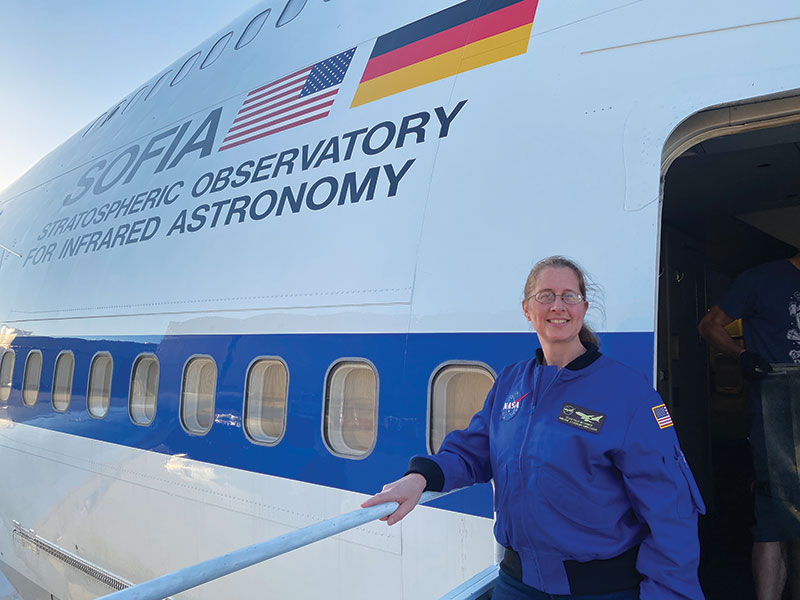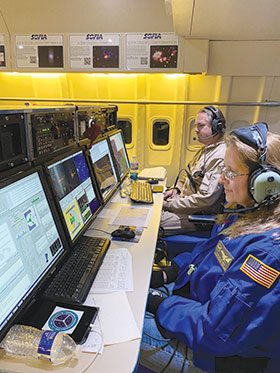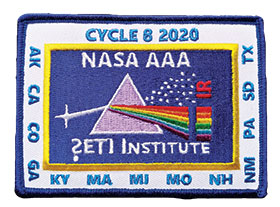Lessons from the Stratosphere:
Fall
2022
Feature
Lessons from the Stratosphere:
An Airborne Astronomy Ambassador Soars Above Earth Aboard SOFIA
By:Korena Di Roma Howley, Contributing Editor
 “It was the darkest sky I have ever seen.” Educator Susan Rolke was more than 38,000 feet above the Earth, looking out at the world from the cockpit of the flying observatory known as SOFIA. The view of the black Pacific Ocean below and the stars and Milky Way above, she says, will always stay with her.
“It was the darkest sky I have ever seen.” Educator Susan Rolke was more than 38,000 feet above the Earth, looking out at the world from the cockpit of the flying observatory known as SOFIA. The view of the black Pacific Ocean below and the stars and Milky Way above, she says, will always stay with her.
For Rolke, who grew up in the small town of Keene, New Hampshire, the sight of the Milky Way in the dark night skies first sparked her interest in astronomy. Though she avidly read everything she could on the subject, she only signed up for a physics class in her senior year of high school to follow the lead of fellow college-bound students. She assumed it would be like other science classes. It wasn’t.
“Up until that point, science was a lot of memorization,” she says. “But with physics you really had to think, and it wasn’t necessarily intuitive … I enjoyed the challenge that it presented. I enjoy pondering the what-ifs and what-could-bes. Physics was really looking at how the natural world worked via the big picture. I fell in love with it.”
Rolke received an academic scholarship to Keene State College, where she studied math and physics and was inducted into Sigma Pi Sigma in 1992. Today Rolke teaches physics and chemistry at a small rural high school, where she enjoys bringing the excitement of science—and especially physics—to her students through the use of cooperative learning, hands-on labs, and whiteboard sessions. “Teaching them is exhilarating,” she says. “I’m always striving to make the class relevant to their lives and to ignite their interest in science.”
In 2020, Rolke was selected to take part in the SETI Institute’s NASA Airborne Astronomy Ambassadors (AAA) program, created to provide professional development to middle school, high school, and community college science instructors. Following the program, instructors communicate current, NASA-enabled research to their students using a science curriculum model created by AAA program staff at the SETI Institute. The goal is to engage students in STEM and inspire pursuit of science-related careers.
Those selected for the highly competitive program receive astrophysics and planetary science training through a two-week curriculum and participate in a one-week immersive experience. For Rolke, that experience was flying aboard the Stratospheric Observatory for Infrared Astronomy (SOFIA), which soars above Earth’s infrared-blocking atmosphere to study cosmic magnetic fields, the origin of cosmic rays, and other phenomena with a 2.7-meter (106-inch) reflecting telescope and other instruments.
After learning about SOFIA and infrared astronomy, Rolke was scheduled to attend a summer workshop and fly on the aircraft in June 2020. The COVID-19 pandemic, however, put the plan on hold. With the aircraft grounded, SETI worked to provide other opportunities for the program’s participants. Rolke submitted the winning art for a mission patch design competition, attended a one-day virtual workshop, and met with SOFIA’s flight crew via Zoom.
When she taught the SETI program in the fall, Rolke wasn’t able to include firsthand information about SOFIA as planned. Still, she enjoyed sharing the program with her students. “They were among the lessons my students remembered most, despite the fact that our school went remote halfway through the two-week curriculum.”
In June 2021, Rolke learned that she would finally fly on SOFIA. Flight week took place at Armstrong Flight Research Center in Palmdale, California, where she attended preflight mission briefings before each of her two overnight flights. During the official crew briefing, the group went over anticipated weather conditions at different altitudes, the flight plan, and the objects that would be observed. Rolke and her fellow AAAs then made their way to the aircraft and took their seats at the educators’ console, which has a series of computer screens showing increasing magnification and detailed information about the telescope, altitude, and temperature.
“Each overnight flight was spectacular in its own way,” Rolke says. The first flight was over the Pacific and lasted eight and a half hours. The second flight, over the US, lasted nine and a half hours.
Shortly after takeoff, Rolke was invited to sit with the telescope operator, who walked her through the telescope operation. Once the telescope door was open, she assisted in the systems check, then input the coordinates for the first object of the night and updated them periodically. “It was really interesting to see the telescope move when we encountered a little turbulence,” she says. “However, in reality it was the plane that was moving around the telescope.”
She later learned that she was the first AAA to operate the telescope. Later in the flight, she spent time with the researchers, who explained the instrument panels at their stations and the data they were collecting using FORCAST, Cornell University’s faint object infrared camera for the SOFIA telescope.
Rolke also spent time in the cockpit with the flight crew, where she learned about the engineering controls and flight path and got her unforgettable glimpse of the night sky above the Pacific Ocean.
For the second flight, Rolke sat in the cockpit during takeoff. “None of my prior flying experiences compared to this,” Rolke says. “The view was amazing, with the sun setting as we flew over Edwards Air Force Base and saw where the space shuttles had landed. Later, Las Vegas was visible as a small, brilliant dot in the desert.”
In addition to the flights, the AAAs met with members of the flight crew over dinner to hear their stories and toured the instrument lab to learn about SOFIA’s instruments.
 “My time at NASA learning about SOFIA was an incredible experience,” Rolke says. “I gained so much knowledge to share with my students. I only wish I had more time there to learn.”
“My time at NASA learning about SOFIA was an incredible experience,” Rolke says. “I gained so much knowledge to share with my students. I only wish I had more time there to learn.”
In addition to her AAA experience, Rolke has participated in other professional development programs. In 2009 she attended a weeklong field class in Makoshika State Park through Montana State University (MSU) in Bozeman. The class is known as Dino Camp to students in the science education master’s program. In 2011 she spent a week in Glacier National Park through another program at MSU, and in 2015 she attended a three-day teacher workshop at McDonald Observatory in Fort Davis, Texas, for which she took part in workshops and night observations.
Rolke feels fortunate to have been able to pursue her interests and bring back what she’s learned.
 “These professional development opportunities have allowed me to develop a more cohesive, big-picture understanding of the world around us and the ability to draw on examples from my experiences when in the classroom,” she says. “I confess that I get really excited whenever I have the opportunity to share my experience on SOFIA. That enthusiasm and excitement is contagious. Being able to speak firsthand about the current research being conducted by SOFIA makes science interesting and real to my students.”
“These professional development opportunities have allowed me to develop a more cohesive, big-picture understanding of the world around us and the ability to draw on examples from my experiences when in the classroom,” she says. “I confess that I get really excited whenever I have the opportunity to share my experience on SOFIA. That enthusiasm and excitement is contagious. Being able to speak firsthand about the current research being conducted by SOFIA makes science interesting and real to my students.”
